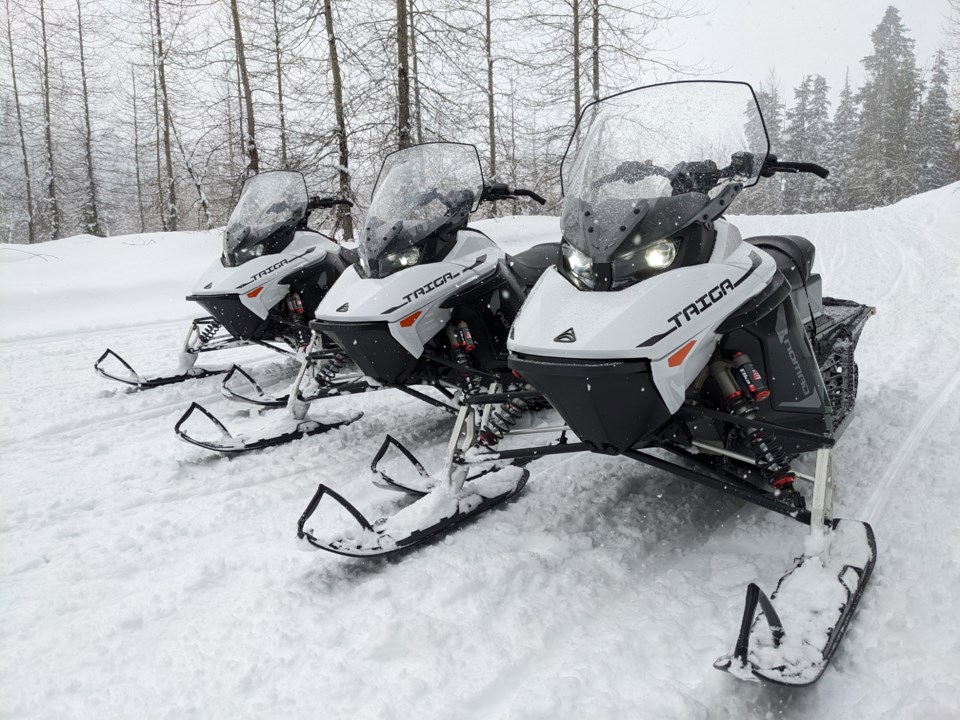If the global supply-chain shortage taught us one thing, it’s that we must remain patient for new technology to make its way to the retail floor. This has been especially true in the electric-vehicle space, with batteries in high demand and low supply, pushing prices up and testing the patience of early adopters. But one electric recreational vehicle we’ve been waiting for has finally arrived.
The Nomad, a fully electric utility snowmobile from Quebec startup Taiga Motors, is rolling off the line in 2023. The company is currently on the road for a public relations tour, demonstrating its now-available products. No more prototypes, no more estimated arrival windows. Ski resorts across North America will have their first electric sleds for operational tasks for the 2023-24 season. Starting price? USD$17,490.
A couple of weekends ago, Taiga held a demo event at Canadian Wilderness Adventures (CWA) in the Callaghan. CWA co-owner Allan Crawford has been a proponent of snowmobile electrification for years, first hosting Taiga’s prototype testing in 2017 and providing ongoing feedback on how to optimize the unit’s design.
The Nomad looks more or less like any other utility snowmobile, with a wide ski stance (for stability when cornering on groomed roads) and a 154-inch (391-centimetre) studded track with 1.6-inch (four-cm) lugs to propel the snowmobile forward. This track setup is designed more for the frozen groomed roads of the Prairies and Eastern Canada and not designed to function in deep coastal snow, but more on that later. The demo units didn’t have stock accessories such as the two-up seat, windshield and cargo racks attached, but all new units ship with them included.
I’ve only driven an electric vehicle once (a friend’s 2021 Nissan Leaf) and the experience was not dissimilar from my first time on an electric snowmobile. The Nomad was quiet to start up and its direct-drive electric motor whined as it began to move. The dash is the typical modern and colourful LCD screen with speed, RPM, kilowatt power output and battery level.
Like e-bikes, the throttle output is divided into three modes. Range is your typical eco/low power mode for preserving battery life. Sport is the zippier mode where you start to feel the acceleration the Nomad is capable of. Then there’s Wild mode, when you have battery to burn or want to show off how fast your Nomad can get up to—100 kilometres an hour.
Obviously, I started in Wild mode. The acceleration was as fast, if not faster, than any gas-powered snowmobile I’ve ridden. But after a couple of drags up the long, straight roads on Sproatt Mountain, I realized how fast the battery was depleting and promptly put the Nomad back into Sport mode. For reference, the range of the Nomad’s battery is 100 km “under ideal conditions.” Cold does affect battery life substantially, which is why the Nomad has a climate-control system for its battery (much like cooling systems for gas snowmobiles), so when starting from cold, the machine requires its own requisite warm-up time.
Electric sleds make so much sense for utility applications. I think back to my snowmobile guiding days, yelling at guests to kill their engines over seven rumbling four-stroke engines and how much more of an experience a snowmobile tour could be in natural surroundings. Ski resorts and industries looking to reduce their winter carbon footprint and fleet maintenance bills will also benefit, both financially and with (slightly) improved climate policy. While fleets are a big part of the Nomad’s market, there are quite a few electric automobile owners buying a snowmobile for the first time to haul firewood to their winter cottage, simply because they now have a quiet, emission-free option to do so.
But the question on everyone’s lips is: when are the electric mountain sleds coming? The ones that can compete with the agile, powerful two-stroke engines that can blast through metres of fresh pow?
I posed this question to Rob Putnam, Taiga’s business development manager, pointing to their Ekko mountain sled, which is still in its prototype phase.
“There’s still some work and testing to do before we can get a range that will meet customers’ expectations. It’s not for lack of power; we know the power is there,” he said in an email. “But mountain sleds need to be light enough to easily tip onto one ski for powder carving, and the bigger and heavier the battery is, the more it affects the handling.”
The other consideration is how much the track spins when pushing through deep snow, getting unstuck, hill climbing, all the fun stuff. All of that required power will affect range as well, and the backcountry mountains of B.C. won’t be getting charging infrastructure anytime soon.
Taiga is the first to market with the electric snowmobile, but industry heavyweight (and fellow Quebecer company) Ski-Doo isn’t far behind. The solution for electric mountain sleds likely isn’t that far away.
Vince Shuley isn’t trading in his 850cc two-stroke just yet. For questions, comments or suggestions for The Outsider email [email protected] or Instagram @whis_vince.






